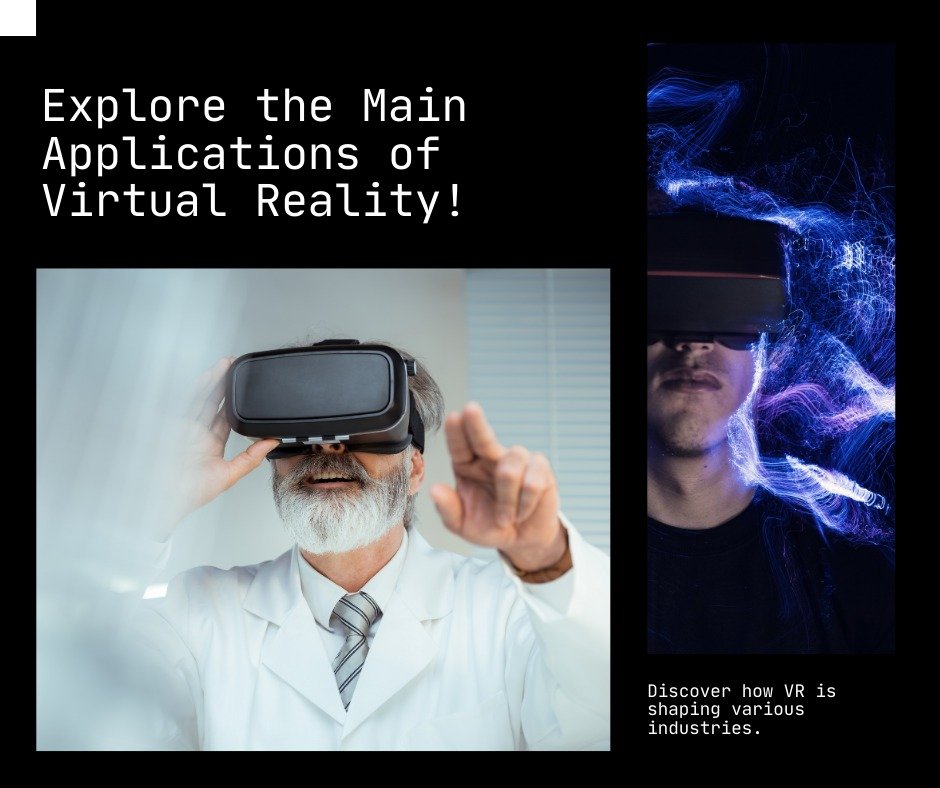
Virtual Reality (VR) has in practically no time transcended the realms of science fiction to turn into a necessary piece of our modern world. This pivotal technology drenches clients in reenacted conditions, obscuring the line between the physical and computerized universes. From entertainment to education, medical care to industry, VR has tracked down its direction into various areas, upsetting the manner in which we experience and associate with technology. How about we dive into the Main applications of Virtual Reality and investigate how it’s reshaping different fields.
Main applications of Virtual Reality
1. Entertainment:
Entertainment stands as one of the essential domains where VR has had a massive effect. VR gaming, specifically, has earned gigantic prominence, offering clients an unrivaled degree of drenching. Whether fighting wild enemies in a dream domain or investigating far off systems, VR transports gamers into distinctive and similar universes, upgrading their gaming encounters complex.
Also, Virtual Reality reaches out past gaming to incorporate vivid narrating encounters. With VR films and intuitive accounts, watchers can step into the shoes of characters and effectively draw in with the storyline, cultivating a more profound close to home association and feeling of presence.
2. Education and Training:
In the domain of education, VR fills in as a useful asset for experiential learning. It empowers understudies to investigate verifiable locales, jump into the profundities of the sea, or even excursion through the human body, giving hands-on growth opportunities that rise above customary reading material and talks. Through Virtual Reality recreations, understudies can accept complex ideas with more prominent lucidity and maintenance.
In like manner, VR holds tremendous potential in the domain of training and expertise advancement. From clinical reproductions for specialists to virtual flight training for pilots, VR offers a safe and financially savvy climate for people to improve their abilities and mastery. By duplicating genuine situations, VR training programs get ready professionals for assorted difficulties they might experience in their particular fields.
3. Healthcare:
The healthcare area has embraced Virtual Reality as an extraordinary instrument for conclusion, treatment, and therapy. VR reenactments permit clinical professionals to picture complex physical designs in 3D, supporting careful preparation and clinical training. Specialists can rehearse complex techniques in a gamble free virtual climate, improving accuracy and lessening the probability of mistakes during genuine medical procedures.
Also, VR-based treatments have shown guarantee in treating different psychological well-being conditions, for example, nervousness issues, PTSD, and fears. By presenting patients to controlled virtual conditions, specialists can work with steady openness therapy, helping people face and defeat their feelings of trepidation in a strong setting.
4. Architecture and Design:
In the domain of architecture and design, Virtual Reality upsets the manner in which professionals conceptualize and introduce their thoughts. Modelers and designers can make vivid virtual walkthroughs of compositional undertakings, permitting clients to investigate spaces and give criticism progressively. This cooperative methodology encourages better correspondence and guarantees that design ideas line up with the client’s vision.
Besides, VR empowers draftsmen and metropolitan organizers to mimic the effect of their designs on the general climate, working with informed direction and reasonable design rehearses. By picturing projects in VR, partners can expect likely difficulties and improve designs before development starts, accordingly limiting expenses and boosting productivity.
5. Corporate Training and Collaboration:
Inside the corporate landscape, Virtual Reality holds tremendous potential for training, collaboration, and remote work. Organizations can use Virtual Reality stages to lead virtual gatherings, studios, and group building works out, independent of geological obstructions. This cultivates more prominent collaboration among remote groups and upgrades generally efficiency.
Furthermore, VR-based reenactments offer vivid training encounters for workers across different businesses, from client care to crisis reaction. By setting learners in sensible situations, VR training programs further develop consistency standards and furnish workers with the abilities expected to succeed in their jobs.
6. Tourism and Travel:
Virtual reality has opened up new outskirts in the domain of tourism and travel, offering vivid encounters that permit people to investigate objections from the solace of their homes. Through Virtual Reality travel encounters, clients can visit notorious landmarks, wander through clamoring city roads, and absorb stunning landscapes, all without leaving their front rooms. This not just takes care of people incapable to travel genuinely yet in addition fills in as a strong promoting device for tourism organizations and friendliness suppliers.
Also, VR improves the arranging system for travelers by giving sensible sneak peaks of facilities and attractions. Virtual inn visits, for example, empower planned visitors to investigate rooms and conveniences prior to reserving a spot, guaranteeing a more educated dynamic cycle. Likewise, objective advertising associations influence Virtual Reality to grandstand the exceptional attractions of their locales, alluring travelers to leave on certifiable undertakings.
You may also like The World of Virtual Reality Arcade Games
7. Rehabilitation and Therapy:
In the field of rehabilitation and therapy, VR offers imaginative answers for physical and mental rehabilitation. By drawing in patients in intelligent virtual conditions, specialists can design customized rehabilitation programs that target explicit coordinated abilities or mental capabilities. For people recuperating from wounds or medical procedures, VR-based rehabilitation practices give a spurring and drawing in option in contrast to customary therapy strategies.
Moreover, VR therapy holds guarantee in tending to conditions like stroke recuperation, horrendous mind injury, and persistent agony on the board. Through vivid encounters and gamified exercises, patients can go through rehabilitation in an invigorating and pleasant way, speeding up their recuperation cycle and working on in general results.
Conclusion
In conclusion, the main applications of virtual reality are a different exhibit of ventures, going from diversion and schooling to healthcare and then some. As technology keeps on propelling, the capability of VR to change how we work, learn, and interface with our general surroundings remains endless. By saddling the vivid force of VR, we can open additional opportunities and rethink the manner in which we experience reality.
You may also like Best Virtual Reality (VR) Software Development Kits
